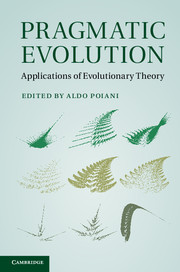Book contents
- Frontmatter
- Contents
- Contributors
- Acknowledgements
- Preface
- Introduction
- Part I Evolution, Ecology and Conservation
- Part II Evolution and Food Production
- 3 Evolution in agriculture
- 4 The evolutionary ecology of pollination and the functional biology of agricultural plants
- 5 The dawn of Darwinian fishery management
- Part III Evolution and Medicine
- Part IV Evolution and Psychology
- Part V Evolution and Computing
- Part VI Evolution and Society
- Index
- Plate Section
- References
4 - The evolutionary ecology of pollination and the functional biology of agricultural plants
from Part II - Evolution and Food Production
Published online by Cambridge University Press: 05 April 2012
- Frontmatter
- Contents
- Contributors
- Acknowledgements
- Preface
- Introduction
- Part I Evolution, Ecology and Conservation
- Part II Evolution and Food Production
- 3 Evolution in agriculture
- 4 The evolutionary ecology of pollination and the functional biology of agricultural plants
- 5 The dawn of Darwinian fishery management
- Part III Evolution and Medicine
- Part IV Evolution and Psychology
- Part V Evolution and Computing
- Part VI Evolution and Society
- Index
- Plate Section
- References
Summary
Agriculture is an evolutionary phenomenon. The popular myth is that agriculture began when humans realised that planting seeds in the ground would make them grow. The truth is that agriculture is a mutualism that evolved (in the biological and not merely colloquial sense of the word) from a novel ecological interaction between plants and humans. At the very origin of this mutualism, cereals rapidly adapted to the novel environment (Allen, 1977). Harvesting favoured the evolution of synchronous seed ripening. The cycle of harvesting, storage and sowing created a strong disadvantage to seed dispersal, which would remove a plant's progeny from the advantageous mutualism. Thus, newly domesticated grains rapidly evolved seed heads with a non-shattering rachis. Sowing favoured the adaptive loss of seed dormancy. These evolutionary changes were effected by people who would have been largely unaware of the selection they were imposing (Allen, 1977).
Today, evolution may seem a remote concern for agriculture, yet an evolutionary understanding of plant reproduction may provide new directions for crop improvement and agricultural management. In this chapter, we consider what evolutionary biology can tell us about crop pollination and yield. Evolutionary biologists interested in pollination have tended to ignore agricultural settings, but well-studied topics such as pollen limitation of seed set and morphological adaptations of flowers for pollination apply equally to wild and domesticated species. More recent concerns, such as the network structure of plant–pollinator interactions in different habitats, may also help us understand how invasive agricultural species interact with established pollination webs.
- Type
- Chapter
- Information
- Pragmatic EvolutionApplications of Evolutionary Theory, pp. 65 - 80Publisher: Cambridge University PressPrint publication year: 2011

